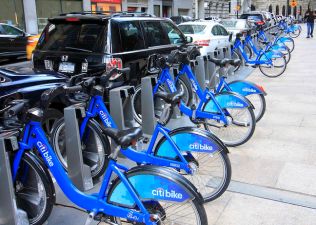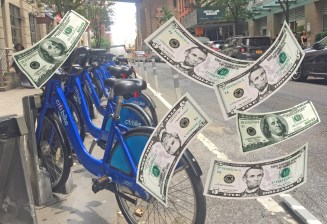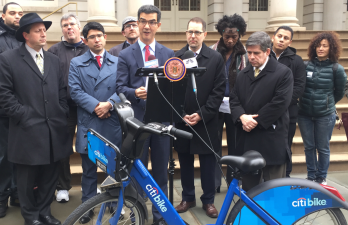Survey Says: City Voters Support Public Money Invested in Bike Share
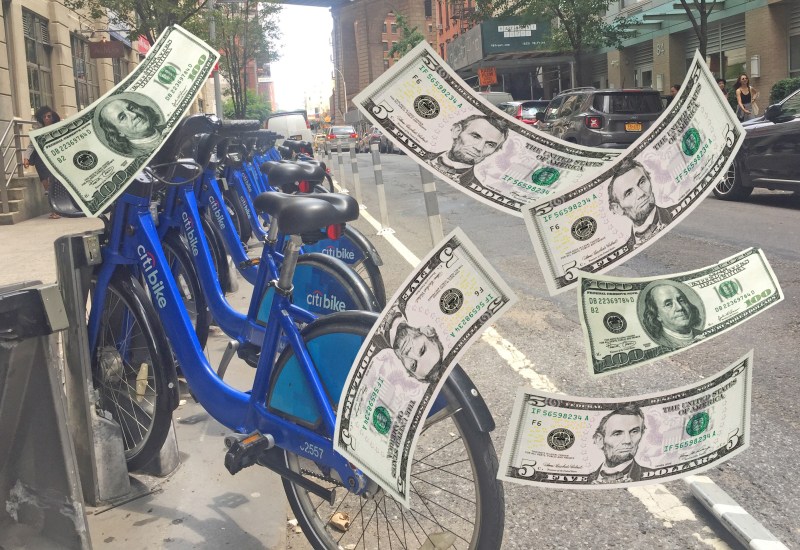
Residents of New York City overwhelmingly approve of using taxpayer dollars to expand cycling and increase the reach and equity of the Citi Bike system — a subsidy tool that the de Blasio administration has steadfastly resisted over its seven-plus years in power, a new survey shows.
In newly released data from an earlier Transportation Alternatives poll, 63 percent of voters said they supported “subsidies that promote cycling in New York City including Citi Bike.” Only 34 percent opposed public subsidies — which are routine for every other form of public transit, including subways, buses, express buses and the mayor’s ferry system.
Unlike those forms of transit, however, Citi Bike has not only recovered from its pandemic dip in ridership — which was smaller than other modes — but began exceeding its pre-pandemic ridership by September, 2020, Sam Schwartz reported:
By April 2021, Citi Bike carried a monthly record of 2,044,103 rides.
Despite the lack of public subsidies, Citi Bike is slowly expanding across the city, though at a much slower pace than if the Lyft-owned system was in a true public private partnership with taxpayers.
“As New York City focuses on recovery, we must capture the momentum of our bike boom and ensure this affordable, equitable, and sustainable option reaches more New Yorkers,” said Marco Conner DiAquoi, the deputy director of Transportation Alternatives. “Our polling makes clear that a broad array of New Yorkers endorse city subsidies for cycling, including for Citi Bike. … A city budget that expands bike share to more New Yorkers isn’t just good policy, it’s good politics too, and we hope our current and future leaders take note.”
New York remains an outlier when it comes to public subsidies for bike share. Washington, Boston, Philadelphia, Jersey City and Hoboken (which will be announced tomorrow) put taxpayer skin the game of reducing car use in a rapidly warming world. Yet even among car owners, support for public cycling subsidies is high, with 58 percent of residents of car-owning households supporting subsidies, according to the TA poll.
The survey of 805 registered voters was conducted late last year and has a margin of error of 3.9 percent either way.
In other findings:
- Lower and middle-income New Yorkers strongly support subsidies, with 65 percent of people making less than $50,000, and 69 percent of people making between $50,000 and $100,000 supporting subsidies.
- Latinx voters are the strongest supporters of subsidies to encourage cycling, with 79 percent of that diverse population supporting taxpayer underwriting.
- Manhattanites support subsidies the most (67 percent), but Staten Islanders are the second biggest supporters, by borough, with 65 percent seeking public support for cycling.
Nonetheless, when asked repeatedly by Streetsblog about public subsidies for this form of public transit, Mayor de Blasio has resisted.
Know what’s working in NYC transportation now? Not transit finances. Not pop up #bikenyc lanes.
The numbers are in, and it’s @CitiBikeNYC.
CitiBike just set a new July ridership level, *exceeding* last year’s record high despite almost no office commutes pic.twitter.com/ksa5oHCubZ
— Bike New York (@bikenewyork) August 18, 2020
“We have something that has been a great success and has not required city money, honestly, it is not my impulse to say, ‘Let’s start putting city money in that,’” the mayor said in 2019. “I stand very comfortably by the notion that certainly up to now not subsidizing it has still allowed us to get the result we needed.”
Former DOT Commissioner Polly Trottenberg said that a subsidy of $400 to $500 million would speed Citi Bike’s expansion deeper into the Bronx, Queens and Brooklyn. As it stands, Citi Bike’s expansion into parts of those boroughs won’t be finished until 2023. A citywide Citi Bike? It’s not on the current mayor’s agenda.
Conner DiAquoi reiterated that it should be.
#BikeBoom latest!
Monthly trips > 2 million is @CitiBikeNYC’s new normal
A seasonal dip is inevitable (??early this week tho !??).
But CitiBike usage in October still ran ahead of last year’s total, even with all the ?? pic.twitter.com/zjvy9QrWan
— Bike New York (@bikenewyork) November 12, 2020
“New investments in our bike share network would make New York City more connected and less congested, and would go hand-in-hand with taking back street space from cars as part of our NYC 25×25 challenge,” he said, referring to TransAlt’s campaign to get mayoral candidates to commit to car-reduction strategies.
A majority of City Council members called for subsidies in 2017. At the time, Citi Bike was operated by Motivate, whose then-CEO Jay Walder said that a five-borough system would not be possible without city subsidies. But that was before Lyft bought the system — yet, still, full New York City coverage remains elusive.
Some cycling advocates are skeptical that Citi Bike specifically needs a subsidy when so much more work needs to be done on the range of issues.
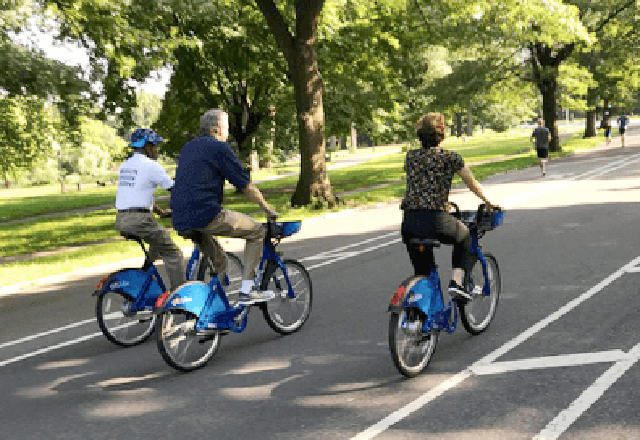
“If the city has more money for bikes, let’s put it into new models of protected bike lanes and deferred Green Wave promises like keeping protected lanes safe during resurfacing and bike lane inspectors,” said Jon Orcutt of Bike New York. “Citi Bike is expanding much more steadily than the network of safe bike lanes.”
Indeed, Citi Bike touted its successes, despite the lack of public funding.
“Citi Bike is one of the most successful bike-share programs in the world because it is a long-term — and increasingly regional — public private partnership,” said Caroline Samponaro, Lyft’s Head of Transit, Bike and Scooter Policy. “With nearly 120 million rides since launch in 2013 and surging ridership over the past year, it’s clear that the system has given New Yorkers a fast, easy and affordable way to get around that has become an indelible part of the city’s public transit network.”
The latest TransAlt data follows an earlier release of polling that revealed strong majorities of New Yorkers (including many car owners) supporting street safety improvements and the repurposing of curbside space for better uses than car storage, as Streetsblog reported.
